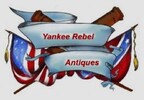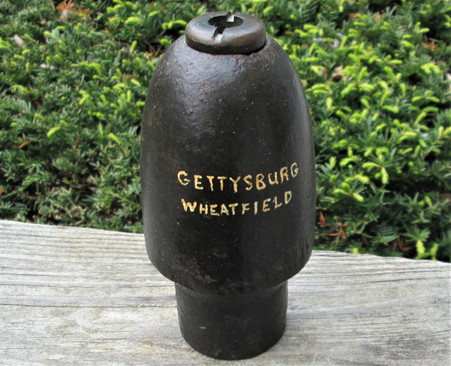 Loading... Please wait...
Loading... Please wait...-
Call us on (973) 810-2976
- My Account
- Gift Certificates
- Items / $0.00
All prices are in All prices are in USD
Categories
- Home
- Sold, Hold, Layaway items
- Rare! Hothkiss Shell from Wheatfield, Gettysburg, Early Rosensteel collection (SOLD)
Rare! Hothkiss Shell from Wheatfield, Gettysburg, Early Rosensteel collection (SOLD)
Out of Stock
Product Description
This is another great piece being offered, which is part of a collection I am currently working on, it is a Hotchkiss fired artillery shell. The projectile is of early manufacture, as evident by the absence of flame grooves. When the projectile was fired, the expanding lead sabot sometimes sealed the bore so well that no flame could pass, thereby keeping the shell's paper time fuze from igniting to explode the shell – probably what happened with this example. The lead sabot and base cup are missing which often separated when fired.
On the top of the shell is the brass time fuze adapted, which still is able to unscrew from the shell. It was recovered between 1935 – 1959 by local Gettysburg resident John Cullison in the historic “Wheatfield” at Gettysburg. (I discuss John Cullison in my book “Battle of Gettysburg – The Relics, Artifacts & Souvenirs”).
The area known as the Wheatfield had three geographic features, all owned by the John Rose family: the 20-acre field itself, the Rose Woods bordering it on the west, and a modest elevation known as Stony Hill, also to the west. Immediately to the southeast was Houck's Ridge and to the south Devil's Den. The fighting here on July 2nd, consisting of numerous confusing attacks and counterattacks over two hours by eleven brigades, earned the field the nickname "Bloody Wheatfield”.
The first engagement in the Wheatfield was that of Anderson's brigade (Hood's division) attacking the 17th Maine of Trobriand's brigade, a spillover from Hood's attack on Houck's Ridge. Although under pressure and with its neighboring regiments on Stony Hill withdrawing, the 17th Maine held its position behind a low stone wall with the assistance of Winslow's battery, and Anderson fell back. Trobriand wrote, "I had never seen any men fight with equal obstinacy."
This shell went from John Cullison’s collection to the Gettysburg Rosensteel collection. The Rosensteel Collection is arguably the most famous collection of Gettysburg relics that have ever existed. John Rosensteel opened his Round Top Museum of Gettysburg artifacts in 1888. The collection, which grew in size as a variety of local collections, such as Cullison’s, was acquired and became the nucleus of the Electric Map Museum collection and ultimately the Gettysburg National Park Museum and Visitor Center collection.
A 1964 advertisement for the Gettysburg National Museum (Electric Map Museum) notes that the John Cullison collection was part of the museum holdings. This Gettysburg artifact not only has wonderful provenance, but it was also found at one of the most famous locations on the battlefield.
As with several other pieces in this collection, I was aware of it for many years, going back from when it first became deacessed from the museum, and just recently was able to acquire it. This shell and fuse are in excellent condition which is indicative of very early battlefield finds. I will include a signed and embossed Certificate of Authenticity with this item.



